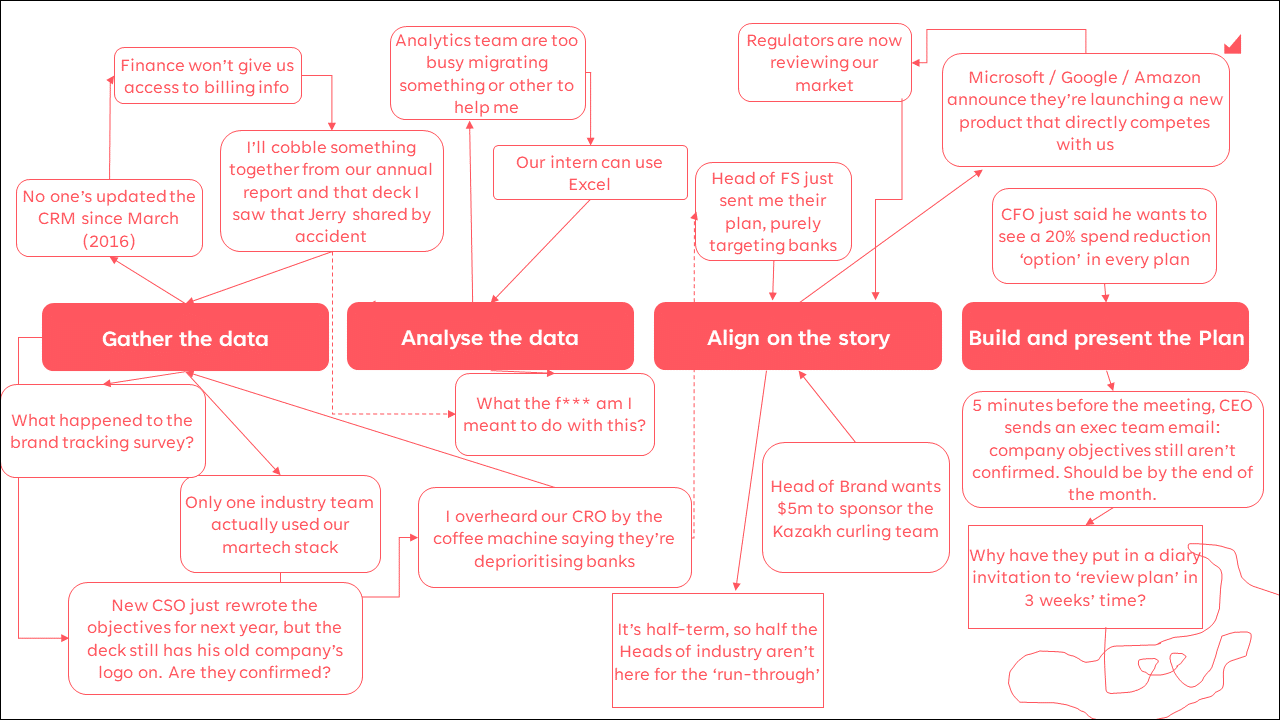“A spoonful of sugar helps the medicine go down” - Mary Poppins
“I think Marketing budgeting is f*cked” - Mark Ritson
“Give it to me one time (huh)
Give it to me two times (huh-huh)
Give it to me three times (huh-huh-huh)
Give it to me four times (huh-huh-huh-huh)” - Toots and the Maytals, 54-46
- - -
Be more Mary
Each year, on the second Monday in September, Mary Poppins, CMO, steps up to lead DreamCo’s annual planning process.
“A spoonful of sugar,” thinks Mary, humming to herself as, in a couple of clicks, she gathers together the recently updated, comprehensive-yet-still-remarkably-concise-and-insightful market research; the perfectly accurate data on last year’s award-winningly, market-movingly successful initiatives; and the clear, simple wish lists of industry leads and BU heads from across the business (which she has, of course, already discussed, tidied and confirmed with them).
DreamCo, being a truly market-oriented company, has always seen Mary as the ideal person to lead the planning process. And they’re right.
With all the necessary data at her fingertips, Mary works hand-in-long-white-glove with the CEO to craft next year’s objectives for the business, neatly aligning them to their medium-term plan. Then, all it takes is a little sanding and planning to slot the industry leads’ and BU heads’ wish lists together to form a simple ladder (supported by just a small number of marketing initiatives) which the company will climb next year in order to reach those objectives.
Mary uses her magic formula (equal parts elixir of ERP, essence of attribution and cream of martech) to determine the budget, which, as ever, the CFO is delighted to receive and sign off with hardly a second look. In fact, Mary has put him in such a jovial mood he sends Mary a hand-drawn thank you card.
Oh my, Mary, what a marketer you are!
- - -
If this sounds familiar, then I’m sorry to have woken you. You’ll feel better after you’ve had a shower and your first coffee.
In practice, the process of planning and budgeting in the real world can feel a bit more like this:

It’s messy, non-linear, and impacted by many things it shouldn’t be.
Maybe Mark is more realistic
Mark Ritson recently took stock of this situation, swore a bit (obvs), drank 8 pints of Guinness (mmm) and decided that the most effective way to combat this chaos, specifically in terms of setting budgets, is to take sensible benchmarks derived from much larger datasets than one company will ever have access to.
He referenced the wonderful work of Grace Kite (set the Marketing budget at 5-10% of revenue) and Binet & Field (spend 60% on brand and 40% on demand), and said that marketers shouldn’t be afraid of admitting what we don’t know in front of the CFO.
He also talked about Heston Blumenthal and chips, which made the whole thing very appetising.
It’s a pragmatic approach, and worth taking into account when you set your budget.
However , there are three considerations pertinent specifically to how B2B marketers should plan. And, for those, we need another inspiration altogether.
Turn to Toots
First, always be wary of applying generalisations to specific situations. For example, the work that Ritson references is B2C-focused. The Toots ratio (as my colleague David van Schaick calls it) from Binet & Field’s work on B2B marketing spend is actually 54% sales activation to 46% brand building. Similarly, Kite’s analysis seems to focus on CPG data, and I don’t know of comparable work based on B2B.
Second, there’s something in the refrain of Toots’ song around agility, testing and iterating:
“Give it to me one time (huh)
Give it to me two times (huh-huh)
Give it to me three times (huh-huh-huh)
Give it to me four times (huh-huh-huh-huh)”
Toots and the Maytals
Instead of just submitting your annual plan once, Toots suggests that you ‘give it to me four times.’ He’s saying that the idea of creating a single Annual Plan, as though it’s a work of unquestionable genius carved in stone, is probably not the right approach.
In practice, the best way to deal with the messiness of a complex process can be to adapt and adjust as new information comes in. Give yourself some space to do this throughout the year. Make your plan an operational document, not a library book. Really, how realistic or useful is it to go into a lot of detail beyond Q1 when you’re writing a plan in October?
In summary: The world isn’t all Mary, but that doesn’t mean you have to be a Markist. Just take a leaf from Toots’ book.
One last thing. This year, annual planning will be more important than ever, with downward pressure on many marketers’ budgets caused by events and trends beyond their control. If you’d like to have a chat about your annual planning, just drop us a message.
We can share solid evidence of why your business should be buying SoV while it’s cheap, as well as the template we’ve used to help our clients define their targets, galvanise their team and defend multimillion-dollar budgets.





